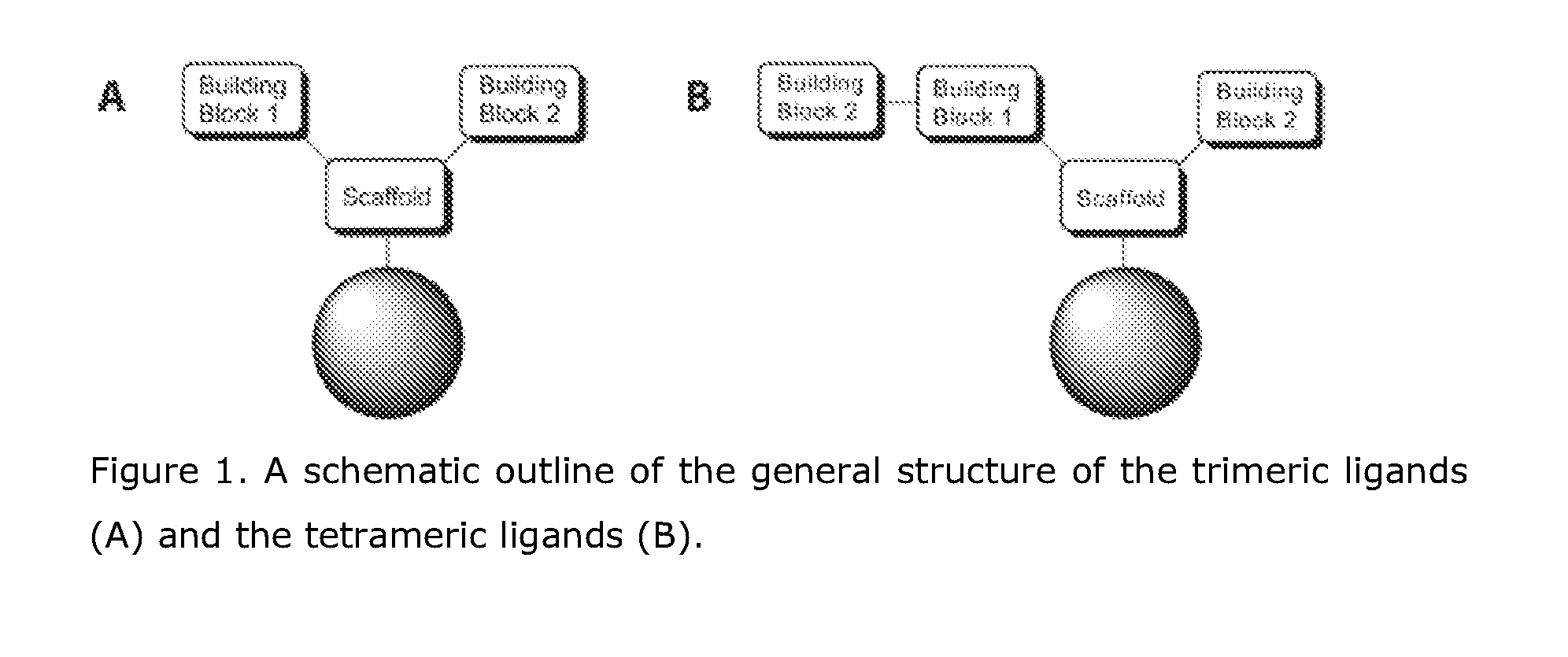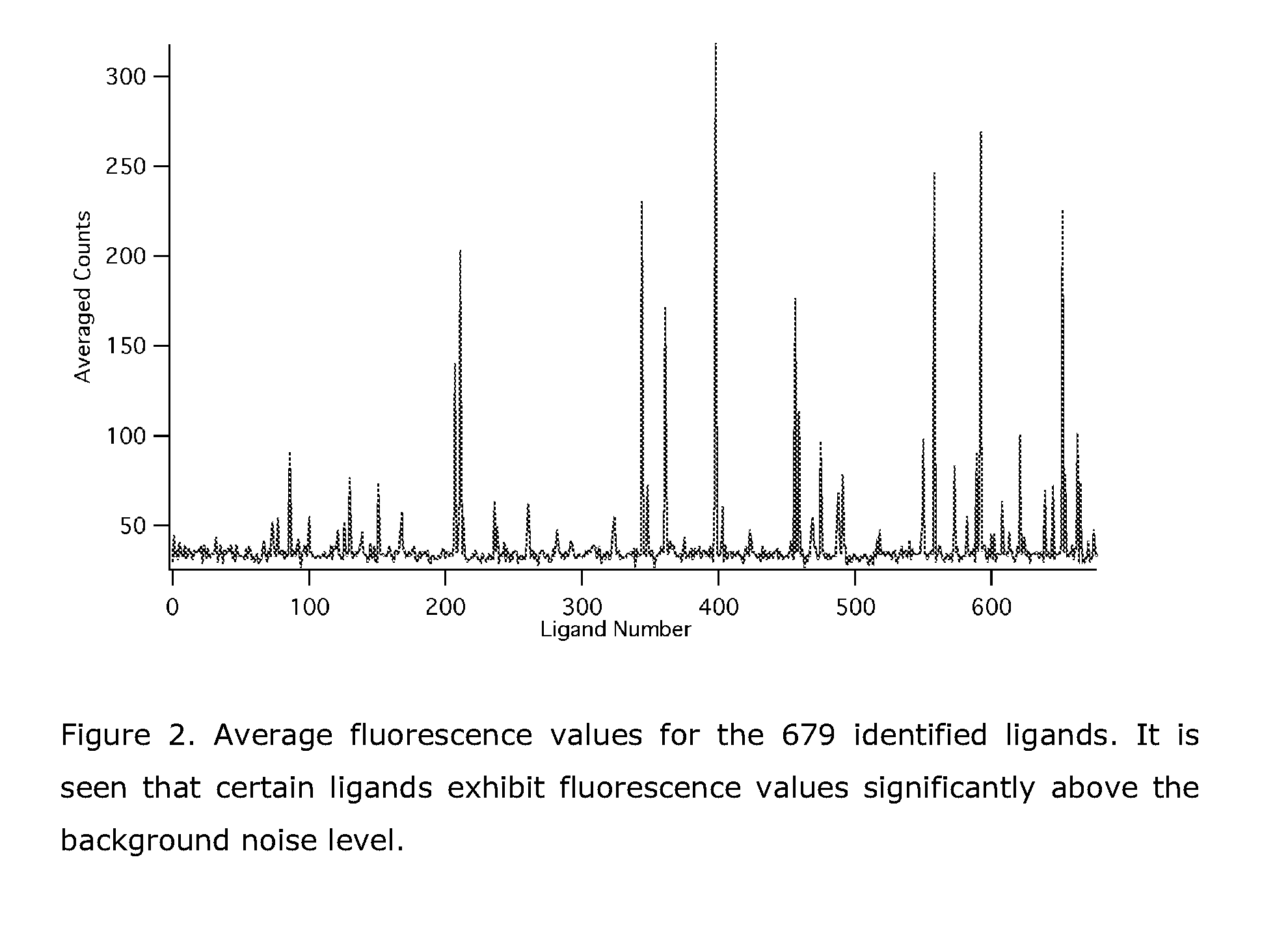Process for the Purification of Antibodies Using Affinity Resins Comprising Specific Ligands
a technology of affinity resin and purification process, which is applied in the field of antibodies purification, can solve the problems of high buffer consumption, low overall yield, and large investment in process equipment, and achieves the effect of cheap and base stabl
- Summary
- Abstract
- Description
- Claims
- Application Information
AI Technical Summary
Benefits of technology
Problems solved by technology
Method used
Image
Examples
example 1
Selection of Building Blocks for Combinatorial Library Using PCA
[0246]The combinatorial library was designed by employing two parallel approaches. First a virtual combinatorial library comprising 229,957 members was generated. For each of the virtual library members a set of 118 physico-chemical descriptors was calculated according to the procedure of Cruciani et al [Ref. Cruciani, C., et al., Molecular fields in quantitative structure-permeation relationships: the VolSurf approach. Journal of Molecular Structure-Theochem, 2000. 503 (1-2): p. 17-30; Cruciani, G., M. Pastor, and W. Guba, VolSurf: a new tool for the pharmacokinetic optimization of lead compounds. European Journal of Pharmaceutical Sciences, 2000. 11: p. S29-S39]. Multivariate statistics were used to analyse the resulting model. In order to simplify the model the 118 descriptors were projected onto two principal components.
[0247]The combinatorial library was then optimized for chemical diversity by employing design of ...
example 2
Synthesis of Combinatorial Library
[0249]The general structure of the combinatorial library of affinity ligands aimed at binding to Fc fragment is shown in FIG. 1. The Scaffolds were selected from aliphatic di-amino-carboxylic acids, Building blocks 1 and Building blocks 2 were selected independently from natural amino acids, unnatural amino acids, and carboxylic acids.
[0250]FIG. 1. A schematic outline of the general structure of the trimeric ligands (A) and the tetrameric ligands (B).
[0251]The combinatorial library was synthesized by employing one-bead-one-compound split and mix solid phase synthesis. The 770 different ligands were synthesized on approximately 20,000 beads optically encoded amino-functional polyethyleneglycol-acrylamide (PEGA) beads. To keep track of all compounds throughout the synthesis, the encoded bead technology was used for reading the optically encoded beads used for the synthesis [WO 2005 / 061094, WO 2005 / 062018. The building blocks used for the synthesis ar...
example 3
Screening of Library and Identification of Binding Ligands
[0254]The combinatorial library was after the last synthesis step divided into 11 reactors. These were washed 10 times with freshly made PBS buffer pH 7.4. To 3.4 ml of Rohdamine X labelled Fc-fragment, was added 1.85 ml PBS buffer at pH 7.4 to yield a final protein concentration of 0.40 mg / ml. 400 μl (160 μg protein) was added to each reactor, and the library was incubated overnight (16 h). The following morning the reactors were washed 10 times with PBS buffer and 10 times with MilliQ water. The bead code and the fluorescence intensity of each bead was then recorded. Data was obtained for 679 of the 770 synthesized ligands. A plot of the average fluorescence for each of the 679 ligands is provided in FIG. 2.
[0255]FIG. 2. Average fluorescence values for the 679 identified ligands. It is seen that certain ligands exhibit fluorescence values significantly above the background noise level.
[0256]Based on the fluorescence and de...
PUM
| Property | Measurement | Unit |
|---|---|---|
| affinity | aaaaa | aaaaa |
| molecular weight | aaaaa | aaaaa |
| Affinity | aaaaa | aaaaa |
Abstract
Description
Claims
Application Information
 Login to View More
Login to View More - R&D
- Intellectual Property
- Life Sciences
- Materials
- Tech Scout
- Unparalleled Data Quality
- Higher Quality Content
- 60% Fewer Hallucinations
Browse by: Latest US Patents, China's latest patents, Technical Efficacy Thesaurus, Application Domain, Technology Topic, Popular Technical Reports.
© 2025 PatSnap. All rights reserved.Legal|Privacy policy|Modern Slavery Act Transparency Statement|Sitemap|About US| Contact US: help@patsnap.com



